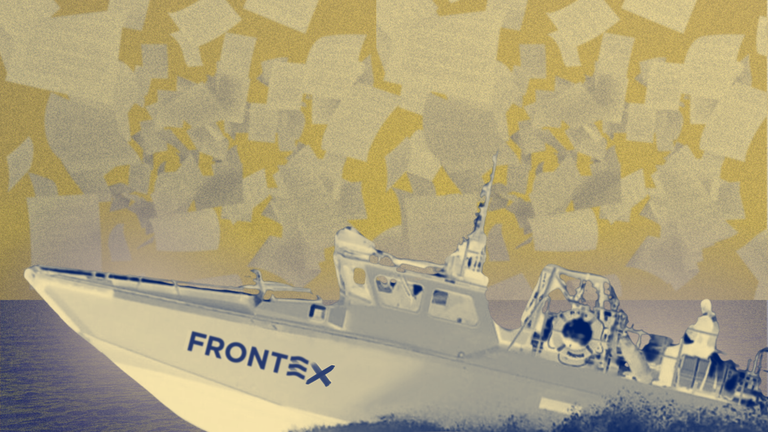Frontex was wrong to keep evidence of a human rights violation secret
In a lawsuit brought by Sea-Watch in cooperation with FragDenStaat, the EU General Court rules that Frontex is allowed to keep most documents about a violation of human rights secret — but not all. Over 100 photographs should not have been kept secret, the court says.

In today’s ruling, the General Court of the EU has said Frontex was wrong to keep secret over 100 photographs they hold regarding their involvement in a human rights violation in the Central Mediterranean.
The decision comes after a lawsuit was filed against Frontex by sea rescue organisation Sea-Watch, in cooperation with FragDenStaat, in April 2022. At the core of the dispute were 73 documents Frontex holds regarding their cooperation with the so-called Libyan Coast Guard, and the extent of their involvement in an illegal pullback – a violation of human rights and international law – at sea. Frontex had refused access to every one of these documents.
During the course of the lawsuit, the court discovered many of the documents held by Frontex contained photographs which had previously not been disclosed or even mentioned by Frontex. Whether the EU border agency hid the existence of these images on purpose, or whether it was an actual mistake, the court is clear: “By failing to mention the existence of those photographs, no justification for the refusal of access was communicated to the applicants.” Frontex’s refusal to provide access to these images is therefore invalid, the court has found.
Sea-Watch and FragDenStaat are calling on Frontex to immediately release these images, which are spread around 29 documents including Frontex internal reports, Frontex internal communication, and communication between Frontex and third actors, such as the so-called Libyan Coast Guard.
The importance of these images is paramount, as they could constitute important evidence of the role Frontex played in a violation of human rights that took place in the Central Mediterranean in July 2021.
Frontex, a drone, and a violation of international law: the events of 30 July 2021
The lawsuit filed against Frontex and the documents the agency wants to keep secret, relating to a particular incident that took place on 30 July 2021. On that day, the Sea-Watch aircraft Seabird and rescue vessel Sea-Watch 3 witnessed and documented a human rights violation and possible crime against humanity in the Central Mediterranean.
A boat with around 20 people on board had managed to make its way from the coast of Libya into international waters. The Sea-Watch 3 was in the vicinity, ready and willing to conduct a rescue mission and bring the people to safety, in Europe.
Instead, Frontex observed and potentially coordinated a violation of international law: the boat in distress was intercepted by the so-called Libyan Coast Guard and the 20 people on board were forced back into Libya. There they face detention conditions that have been described by German diplomats as “concentration camp-like”.
The documents that the lawsuit disputes have the potential of shedding clarity on what happened that day and, crucially, what was Frontex’s role. As an investigation by Human Rights Watch and Border Forensics concluded, Frontex was the likely coordinator of the illegal pullback by having alerted the Libyan Coast Guard to the scene. For instance, through the lawsuit, it became clear that Frontex holds multiple correspondence (36 documents) with third actors, including the so-called Libyan Coast Guard.
To this extent, and while the court has stated that Frontex was wrong in refusing access to the footage it holds, it has sided with the border agency in keeping anything but those images secret. This is a concerning outcome: documents such as correspondence between Frontex and the so-called Libyan Coast Guard, as well as Frontex internal reports and accounts of what happened, contain key evidence essential for accountability over a human rights violations.
By allowing Frontex to withhold a big part of the documents it holds, agreeing with Frontex on its arguments that transparency endangers public security, and that disclosing even parts of the documents would be excessive burden for the agency, Frontex’s pattern of impunity for its actions seems reinforced by the court.
It is in this context that disclosure of the footage Frontex holds is essential; a crucial step towards holding an otherwise rogue border agency accountable for its actions.
Disclosure: a test to Frontex’s new transparency promises
Since the agency’s new Director, Hans Leijtens, took office in March 2023, he has vowed to reform Frontex’s (in)transparency culture: He declared to the media “there is nothing secret about Frontex” and that he would promote a nothing-to-hide attitude while improving transparency and putting an end to “defensive attitudes.” “We can’t do our work when we are not trusted,” he said.
Today’s judgment by the EU court puts those commitments to test. If Leijtens is truthful and serious about a change towards greater transparency, Frontex should disclose the photographs it could not justify to keep secret before the eyes of the court.
“The real game changer,” Leijten has said, is “being more transparent.” “There should be nothing secret about what we’re doing”.
Frontex now has two months and ten days to file an appeal before the higher EU court, the Court of Justice of the EU. An appeal, however, which would extend the legal dispute and entail a refusal to make the 30 July footage it holds public, would be a clear backtrack from Leijtens’ transparency pledges.
This article is available in other languages.
